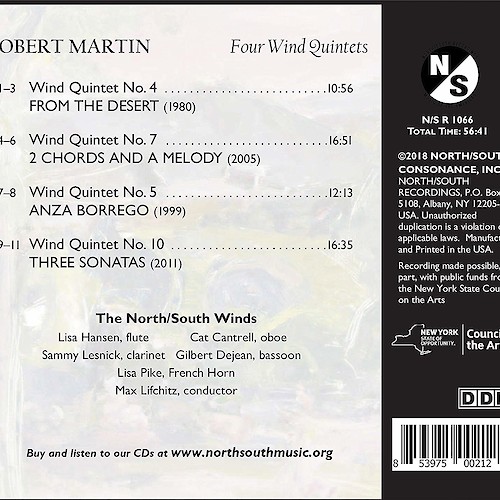

The North/South Winds
Lisa Hansen, flute
Cat Cantrell, oboe
Sammy Lesnick, clarinet
Gilbert, bassoon
Lisa Pike, french horn
Max Lifchitz, conductor
Composers put pen on paper, but they also have to put bread on the table. Robert Martin took the unusual course of spending his professional life on Wall Street, well outside the music establishment. He made this choice in 1980, after a prestigious musical education at the Peabody Conservatory, followed by equally prestigious scholarships, including a Fulbright. In their different but parallel ways T.S. Eliot, Charles Ives, and Wallace Stevens made the same decision, and in every case freedom from economic pressures carried with it a freedom from academics and the conventional art scene.
What does a talented composer do in such circumstances? Martin, born in 1952, probably comes closest to Stevens, in that he has developed a private, cryptic, condensed, and at times aphoristic style, as displayed in these four woodwind quintets—Martin prefers “wind quintet,” even though the instrumentation is the conventional flute, oboe, clarinet, bassoon, and French horn. All are challenging works in their compression and rigor. Martin’s intelligent, detailed program notes give the listener a toehold on each piece, but the listening experience itself is rather like dropping in on a laboratory for quintet experimentation.
As Martin says of Quintet No. 7, subtitled “2 Chords and a Melody,” “Do not expect generosity and extravagance, rather parsimoniousness and efficiency.” This piece lies the closest to Webern of the four works on the program, comprising multifold reworking of the two chords and flute melody that open the first movement. All the quintets are brief, lasting between 10 and 16 minutes to span two or three movements. What leavens their rigor is first, Martin’s adroit use of the five instruments, from which he extracts plenty of color as he mixes and matches their timbres, and second, his free shift in and out of tonality. As Schoenberg originally intended, the liberation of the dissonance isn’t the same as an obsession with dissonance. “Wrong” notes add to the composer’s vocabulary and extend the formal possibilities beyond late-Romantic chromaticism.
Occasionally there are hints of a program, as in Quintet No. 4 “From the Desert,” which was inspired by Martin’s response to the desert landscape surrounding the Dead Sea. The lamentation of the French horn in the finale reflects the composer’s solitary reflections on civilizations that have risen from the desert and returned to dust. The two-movement Quintet No. 5 “Anza Borrego” returns to the desert, this time in Southern California. Having made sojourns in many deserts, Martin reveals a transcendental streak that ties him to Ives, because in a desert’s desolation he seeks “to reflect on what lies beyond nothingness.” Quintet No 10 “Three Sonatas” poses the challenge of reviving aspects of sonata form without regressing to or imitating sonatas of the past.
I’ll venture to say that these works are aimed at listeners who can appreciate the years Martin has devoted to pondering the primal materials of music at a level of finely articulated finesse. Meticulous precision stands foremost in each composition, and at times one gets the impression of intellectual needlepoint. On those terms this album deserves a recommendation, while also adding that the performances by the North/South Winds under conductor Max Lifchitz are quite accomplished.
Four stars: Meticulous, precise explorations of the modern woodwind quintet
– Huntley Dent